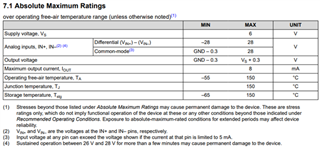Hi,
I have a question about the differential voltage on this part. The datasheet says it can exceed 28 volts as long as the current is limited to 5mA. We want to sense the voltage across a FET. When the FET is off, the inputs will see battery voltage. In some cases the inputs may see a load dump voltage of 35v. Is that an issue if the current is kept below 5mA? can you please provide more context of the 5mA value?

Thanks



